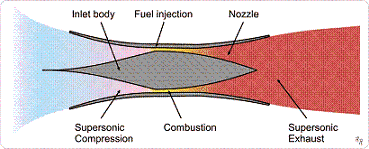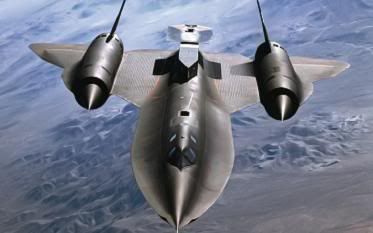Post by glactus on Jul 1, 2011 1:40:06 GMT

A scramjet illustration
A scramjet (supersonic combustion ramjet) is a variant of a ramjet air breathing jet engine in which combustion takes place in supersonic airflow. As in ramjets, a scramjet relies on high vehicle speed to forcefully compress and decelerate the incoming air before combustion (hence ramjet), but whereas a ramjet decelerates the air to subsonic velocities before combustion, airflow in a scramjet is supersonic throughout the entire engine. This allows the scramjet to efficiently operate at extremely high speeds.

NASA X43-A Scramjet
Theoretical projections place the top speed of a scramjet between Mach 12 and Mach 24, which is near orbital velocity. The fastest air-breathing aircraft is a SCRAM jet design, the NASA X-43A which reached Mach 9.8. For comparison, the second fastest air-breathing aircraft, the manned SR 71 Blackbird, has a cruising speed of Mach 3.2, fast enough to evade 4000 missiles that were fired at it when over foreign territory.

The SR 71 Blackbird. Evaded 4000 missiles
The scramjet is composed of three basic components: a converging inlet, where incoming air is compressed and decelerated; a combustor, where gaseous fuel is burned with atmospheric oxygen to produce heat; and a diverging nozzle, where the heated air is accelerated to produce thrust.
Unlike a typical jet engine, such as a turbojet or turbofan engine, a scramjet does not use rotating, fan-like components to compress the air; rather, the achievable speed of the aircraft moving through the atmosphere causes the air to compress within the inlet. As such, no moving parts are needed in a scramjet, which greatly simplifies both the design and operation of the engine.
Due to the nature of their design, scramjet operation is limited to near-hypersonic velocities. As they lack mechanical compressors, scramjets require the high kinetic energy of a hypersonic flow to compress the incoming air to operational conditions. Thus, a scramjet-powered vehicle must be accelerated to the required velocity by some other means of propulsion, such as turbojet, railgun, or rocket engines.
Looking at the Scramjet
Credits: These are NASA/JPL/US Air force images
Text by Wikipedia/Glactus
Telescope in avatar:Meade 16" LX 200
Astronomer in avatar: Glactus


